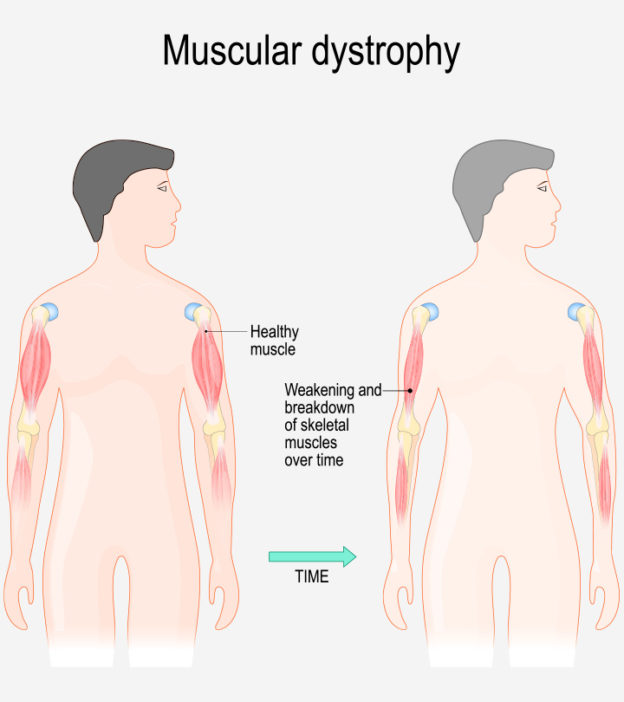
Muscular dystrophy in children is a collective name for over 30 different genetic neuromuscular disorders. Each disorder causes muscles weakness and wasting (atrophy). The progressive muscle weakness leads to difficulty in movement and loss of control (1).
Duchenne muscular dystrophy (DMD) is the most common disorder affecting young boys from three to six years (2). While there is no cure, different therapies can help lessen the severity and prevent complications.
Read about muscular dystrophy in children, including its types, causes, symptoms, and treatment.
What Causes Muscular Dystrophy In Children?
Muscular dystrophy could result from a mutated gene that affects proteins in the muscles. It further prevents the proteins from working accurately and efficiently. Different dystrophies occur from various mutations. A child can inherit mutated genes from the parents, but in some cases, the mutation can occur spontaneously and passes to future generations (3).
What Are The Types And Symptoms Of Muscular Dystrophy In Children?
Several types of muscular dystrophy can occur during childhood and adulthood. Here we discuss the common childhood muscular dystrophies that progress and affect muscles in various ways (4):
- Duchenne muscular dystrophy (DMD): It occurs due to a faulty gene on the X chromosome. The condition primarily affects boys and is seen in around 50% of people with muscular dystrophy (3) (5). It affects children from three to six years.
Symptoms include
- Difficulty in standing up from a sitting or lying position
- Wobbly walk
- Problem in jumping and running
- Falling frequently
- Swollen calf muscles (3)
- Becker muscular dystrophy: This condition is due to the mutation in the DMD gene responsible for the production of dystrophin protein for maintaining the muscle (6). It may occur during early adulthood. Similar to DMD, it is more common in males.
Symptoms include
- Falling frequently
- Walking on tiptoes
- Frequent muscle cramps
- Late appearance of symptoms than DMD (3)
- Congenital muscular dystrophy (CMD): It develops at birth with an incidence of fewer than three cases in 100,000 births. CMD is believed to occur due to genetic mutations (7).
Symptoms include
- Weakness along with weak muscle tone (hypotonia) at birth
- Delay in walking
- Limp or floppy baby
- Poor head and neck control
- Emery-Dreifuss muscular dystrophy (EDMD): It is rare, with the X-linked defect occurring in around one out of 100,000 people (8). It can occur at any age between childhood to early teenage.
Symptoms include
- Stiffness of the spine
- Weakening of muscles from the upper arms and lower legs
- Loss of movement in the elbows, knees, spine, ankles, and back of the neck
- Locking of elbows in a bending position (3)
- Facioscapulohumeral muscular dystrophy: It occurs due to deletion of genetic material from a specific region of the DNA. The deleted gene is passed on in the form of autosomal dominant inheritance, where the missing DNA base pair is enough to cause the disease (9). This muscular dystrophy can affect people in their childhood or early adulthood.
Symptoms include
- Difficulty in hearing, talking, swallowing, and chewing
- Sloped shoulders or winged shoulder blades
- Muscle weakening around the mouth and eyes
- Curved spine (3)
- Limb-girdle muscular dystrophy (LGMD): Resulting from mutations in several genes, LGMD affects around one in 14,500 to one in 123,000 people (10). It mostly occurs in people during their late childhood or middle age.
Symptoms include
- Stiffness of the spine
- Wobbly walk
- Falling frequently
- Muscle weakening around the hips spreading through the neck, shoulders, and legs (3)
What Are The Complications of Muscular Dystrophy?
Muscular dystrophy can impact the muscles, heart, and lungs, leading to complications such as (11):
- Respiratory tract infections, such as pneumonia
- Heart disorders, including arrhythmias and heart failure
How Is Muscular Dystrophy Diagnosed In Children?
Diagnosis of muscular dystrophy in children involves the following tests (2) (12):
- Genetic test: This is performed to confirm if the cause behind the dystrophy is a genetic mutation.
- Blood test: A blood test can detect the presence of creatine kinase enzyme. High levels of the enzyme will indicate a muscle disorder.
- Muscle biopsy: A confirmatory primary test, where a small portion of the muscle is examined under the microscope to look for changes in the muscle tissue.
- Electromyogram (EMG): This test is carried out to determine if the muscle weakness is due to destroyed muscle tissue rather than a nerve disorder.
- Electrocardiogram (ECG or EKG): The test monitors the heart’s electrical activity for detecting any abnormalities in the heart rhythm or heart muscle damage.
How Is Muscular Dystrophy Treated In Children?
Currently, there is no cure for muscular dystrophy. However, the following management therapies and treatments are recommended depending on the type of muscular dystrophy, age of the child, and the extent of the condition.
- Physical and occupational therapy: This could help the muscles function and prevent the joints from becoming stiff. Through the therapy, the child will be assisted with orthotics to improve their walk and maintain their balance (13).
- Supportive devices: Braces or splints offer protection, support, and prevent deformity (12). Patients with weakened lungs may require assisted ventilation to ease of breathing during the nighttime (13).
- Medications: Oral corticosteroids are administered to help the children with some muscular dystrophies walk for longer durations (14).
- Some other management therapies include nutritional counseling, psychological counseling, and breathing exercises to improve quality of life.
Surgical interventions are also recommended to manage some conditions (12) (13):
- Scoliosis surgery for correction of curved backbones and improvement of breathing.
- Muscle-release surgery to treat muscle contractures and increase mobility.
Can Muscular Dystrophy Be Prevented?
Muscular dystrophy is a genetic disease and cannot be prevented. However, in case of a family history of muscular dystrophy, parents can get tested to know if they are carriers and plan accordingly.
What Is The Life Expectancy Of A Child With Muscular Dystrophy?
The life expectancy depends on the type of muscular dystrophy the child develops:
- Duchenne: The child might live beyond 30 years and even marry and have children (15).
- Becker: The child has an average life expectancy of 40 years (16).
- Congenital: This type has a poor prognosis, with most children not surviving up to adolescence (17).
- Emery-Dreifuss: Children may develop heart-related problems anytime between ten and 19 years with EDMD (18).
- Facioscapulohumeral: The prognosis looks good with a life span of several decades of onset (4).
Th muscular dystrophy is a group of genetic disorders affecting the muscles. Also, there is no effective cure to treat muscular dystrophy rather than managing its symptoms. You can support your child by providing the best care they require. Ensure they take medications and follow all the doctor’s instructions. Remember, with the advancing technologies and treatments, children with muscular dystrophy can go to school, college and study.
Key Pointers
- A child with muscular dystrophy experiences muscle weakness and loss.
- Some common types of muscular dystrophy include Duchenne muscular dystrophy (DMD) and Becker muscular dystrophy (BMD).
- It is caused by gene mutations and deletions, which affect the proteins of the muscles.
- Physical and occupational therapies, supportive devices, and medications could help manage the condition.
References:


 PARENTING TIPS
PARENTING TIPS PREGNANCY
PREGNANCY BABY CARE
BABY CARE TODDLERS
TODDLERS TEENS
TEENS HEALTH CARE
HEALTH CARE ACTIVITIES & CRAFTS
ACTIVITIES & CRAFTS

